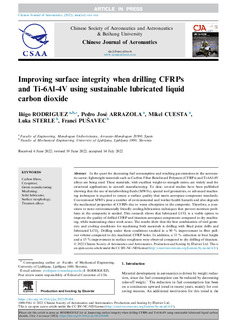| dc.rights.license | Attribution-NonCommercial-NoDerivatives 4.0 International | * |
| dc.contributor.author | rodriguez, Iñigo | |
| dc.contributor.author | ARRAZOLA, PEDRO JOSE | |
| dc.contributor.author | CUESTA ZABALAJAUREGUI, MIKEL | |
| dc.contributor.other | Sterle, Luka | |
| dc.contributor.other | Pusavec, Franci | |
| dc.date.accessioned | 2023-01-16T11:32:54Z | |
| dc.date.available | 2023-01-16T11:32:54Z | |
| dc.date.issued | 2022 | |
| dc.identifier.issn | 2588-9230 | en |
| dc.identifier.other | https://katalogoa.mondragon.edu/janium-bin/janium_login_opac.pl?find&ficha_no=171248 | en |
| dc.identifier.uri | https://hdl.handle.net/20.500.11984/5958 | |
| dc.description.abstract | In the quest for decreasing fuel consumption and resulting gas emissions in the aeronautic sector, lightweight materials such as Carbon Fiber Reinforced Polymers (CFRPs) and Ti-6Al-4V alloys are being used. These materials, with excellent weight-to-strength ratios, are widely used for structural applications in aircraft manufacturing. To date, several studies have been published showing that the use of metalworking fluids (MWFs), special tool geometries, or advanced machining techniques is required to ensure a surface quality that meets aerospace component standards. Conventional MWFs pose a number of environmental and worker health hazards and also degrade the mechanical properties of CFRPs due to water absorption in the composite. Therefore, a transition to more environmentally friendly cooling/lubrication techniques that prevent moisture problems in the composite is needed. This research shows that lubricated LCO2 is a viable option to improve the quality of drilled CFRP and titanium aerospace components compared to dry machining, while maintaining clean work areas. The results show that the best combination of tool geometry and cooling conditions for machining both materials is drilling with Brad point drills and lubricated LCO2. Drilling under these conditions resulted in a 90 % improvement in fiber pull-out volume compared to dry machined CFRP holes. In addition, a 33 % reduction in burr height and a 15 % improvement in surface roughness were observed compared to dry drilling of titanium. | en |
| dc.language.iso | eng | en |
| dc.publisher | Elsevier | en |
| dc.rights | © 2022 Chinese Society of Aeronautics and Astronautics | en |
| dc.rights.uri | http://creativecommons.org/licenses/by-nc-nd/4.0/ | * |
| dc.subject | Carbon fibers | en |
| dc.subject | Cryogenics | en |
| dc.subject | Green manufacturing | en |
| dc.subject | Machining | en |
| dc.subject | Solid lubricants | en |
| dc.subject | Surface morphology | en |
| dc.subject | Titanium alloys | en |
| dc.title | Improving surface integrity when drilling CFRPs and Ti-6Al-4V using sustainable lubricated liquid carbon dioxide | en |
| dc.type | http://purl.org/coar/resource_type/c_6501 | |
| dcterms.accessRights | http://purl.org/coar/access_right/c_abf2 | en |
| dcterms.source | Chinese Journal of Aeronautics | en |
| local.contributor.group | Mecanizado de alto rendimiento | es |
| local.description.peerreviewed | true | en |
| local.identifier.doi | https://doi.org/10.1016/j.cja.2022.09.004 | en |
| local.contributor.otherinstitution | https://ror.org/05njb9z20 | es |
| local.source.details | September, 2022 | en |
| oaire.format.mimetype | application/pdf | |
| oaire.file | $DSPACE\assetstore | |
| oaire.resourceType | http://purl.org/coar/resource_type/c_6501 | en |
| oaire.version | http://purl.org/coar/version/c_970fb48d4fbd8a85 | en |








